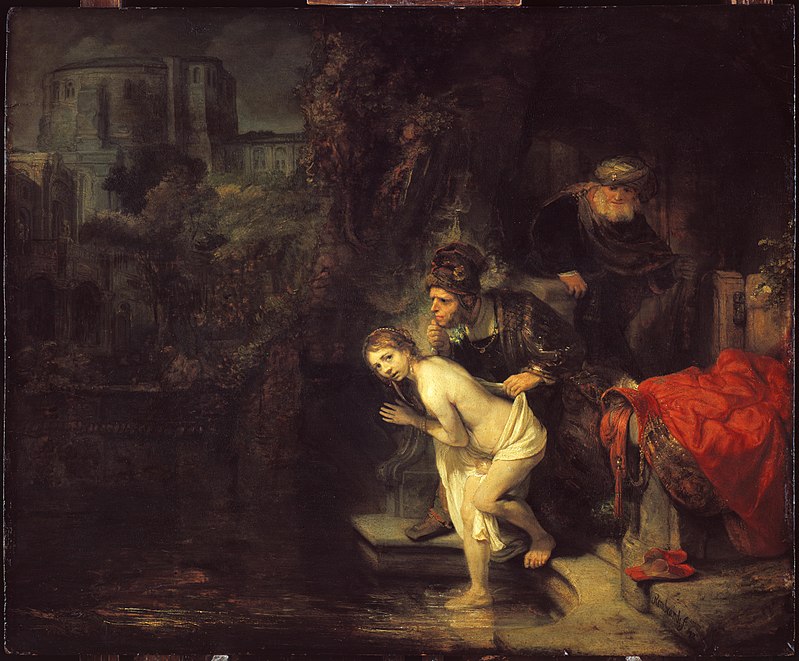You are walking down the street alone, you see a bystander from the corner of your eye and you don’t make eye contact but you feel they are watching, gawking. Just by that feeling of their piercing gaze, you’re already aware that the bystander is a man. This is the Male Gaze and repercussions are almost never positive ones. Many describe the Male Gaze as the assessment that is made by men towards women that displays them as objects in the male mind, dehumanizing them and making them feel unsafe or causing extreme discomfort. In paintings and portraits, the male gaze can be described as the depiction of men painting portraits of women in a way that is objectifying them as if they are only there for a man’s viewing pleasure. John Berger in “Way of Seeing” describes women in art, “men act and women appear. Men look at women … Thus she turns herself into an object - and most particularly an object of vision: a sight” (Berger 47). Berger is critiquing the very fact that women in most artworks, were painted for a man’s desires and not to be seen how she truly is. This takes the voice away from the woman in the painting and promotes her oppression under the male gaze. This male gaze is most prevalent in popular culture because most artists are male do to more opportunities given to men in the art world. This is how the world views woman because the artist is probably using their male gaze. The picture below displays this gaze due to the fact that the painter was a man named Rembrandt Harmenszoon van Rijn. You can clearly see in the painting that not only is the male gaze featured by the perspective of the painter outside the painting, but also the gaze of two men leaning closer to the women within the painting. The man more apparent in the painting seems to reach out and grasp the sheet around her as if to touch her, which causes the woman to lean awkwardly in the painting away from the man in extreme discomfort.
 |
| Susanna and The Elders, Rembrandt, 1647 |
| Jael and Sisera, Artemisia Gentileschi, 1620 |
The Male Gaze is a result of the ever so popular patriarchy. Men feel that they have the right to gawk at women because the patriarchy teaches them that women are there for their enjoyment. Patriarchy is used to describe the always present hierarchy that is displayed in everyday life that exhibits that men are more dominant and superior to women; many if not most societies have been built on top of the patriarchy, enabling men to be seen as leaders and women seen as the property of men. Bell Hooks in “Understanding Patriarchy”, describes patriarchy as a “political social system that insists that males are inherently dominant, superior to everyone and everything deemed weak, especially females, and endowed with the right to dominate and rule over the weak and to maintain that dominance through various form of psychological terrorism and violence” (Hooks 18). The patriarchy has oppressed women for hundreds of years and only quite recently were women given a platform to discuss the degrading mentality of the patriarchy. The patriarchy traps women in a box where women are expected to act accordingly by the rules and expectations that a male-dominated society created, giving men the upper hand and constantly putting down women who refuse to conform to the patriarchy in any way, shape, or form. For example, women from a young age are taught by popular media to find a man as opposed to being taught to be a self-sufficient leader. In the eyes of the patriarchy, women must be enough, but not too much. A woman who has many sexual partners is bashed and shunned by not only men but other woman. Whereas a man with many sexual partners is just a man. The picture above, Jael and Sisera by Artemisia Gentileschi, is a rather forgotten painting because it depicts a woman with the power and not the man. In the 1600’s, when this was painted, this was seen as frowned upon and an utmost disgrace. The woman is shown about to kill a man in her lap with a nail to his head. It is no wonder the painting was forgotten and put into Google’s collection of “The Women Painters Overlooked by Art History”: https://artsandculture.google.com/theme/7AJCHFiEkqVKJg For a deeper reading of the Male Gaze and Patriarchy in Art History, check out: http://www.oxfordartonline.com/page/women-in-the-visual-arts
Works Cited
Berger, John. Ways of Seeing. London: British Broadcasting Corporation and Penguin Books. 1972. Print.
Hook, Bell. "Understanding Patriarchy". Willing to Change. Atria Books 2004.
No comments:
Post a Comment